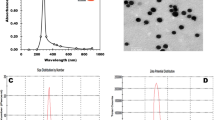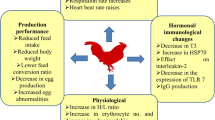Abstract
The purpose of this study was to assess the effects of artificial shade, tree shade, and no shade on physiological changes, oxidative stress, and total antioxidant power in Thai Brahman cattle. Twenty-one cattle were divided into three groups: cattle maintained under artificial shade, under tree shade, and without shade. On days 1, 7, 14, 21, and 28 of the experimental period, after the cattle were set in individual stalls for 2 h, physiological changes, thiobarbituric acid reactive substances (TBARS), and total antioxidant power were investigated. The results revealed that the respiratory rate, heart rate, sweat rate and the neutrophil/lymphocyte ratio of the no-shade cattle were significantly higher than those of cattle maintained under artificial shade and tree shade (P < 0.05). During the early period of heat exposure, the total antioxidant power of the no-shade cattle was lower than those of cattle maintained under artificial shade and tree shade, but the total antioxidant power of cattle maintained under artificial shade and tree shade were not different (P > 0.05). However, rectal temperature and packed cell volume of the cattle in all groups did not differ (P > 0.05). These results showed that artificial shade and tree shade can protect cattle from sunlight compared to no shade, and that the effectiveness of tree shade for sunlight protection is at an intermediate level.

Similar content being viewed by others
References
Anderson BH, Watson DL, Colditz IG (1999) The effect of dexamethason on some immunological parameters in cattle. Vet Res Commun 23:399–413. doi:10.1023/A:1006365324335
Beatty DT, Barnes A, Taylor E, Pethick D, McCarthy M, Maloney SK (2006) Physiological responses of Bos taurus and Bos indicus cattle to prolonged, continuous heat and humidity. J Anim Sci 84:972–985
Benzie IFF, Strain JJ (1996) The ferric reducing ability of plasma (FRAP) as a measure of ‘antioxidant power’: the FRAP assay. Anal Biochem 239:70–76
Berman A (2005) Estimates of heat stress relief needs for Holstein dairy cows. J Anim Sci 83:1377–1384
Bernabucci U, Ronchi B, Lacetera N, Nardone A (2002) Markers of oxidative status in plasma and erythrocytes of transition dairy cows during hot season. J Dairy Sci 85:2173–2179
Brown-Brandl TM, Eigenberg RA, Nienaber JA, Hahn GL (2005) Dynamic response indicators of heat stress in shaded and non-shaded feedlot cattle, Part 1: analyses of indicators. Biosys Eng 90:451–462. doi:10.1007/s00484-004-0250-2
Bueno AR, Rasby R, Clemens ET (2003) Age at weaning and the endocrine response to stress. Arq Bras Med Vet Zootec 55:1–7
Circu ML, Aw TY (2010) Reactive oxygen species, cellular redox systems, and apoptosis. Free Radic Biol Med 48:749–762. doi:10.1016/j.freeradbiomed.2009.12.022
Eigenberg RA, Hahn GL, Nienaber JA, Brown-Brandl TM, Spiers DE (2000) Development of a new respiration rate monitor for cattle. Trans ASAE 43:723–728
Eigenberg RA, Brown-Brandl TM, Nienaber JA (2009) Shade material evaluation using a cattle response model and meteorological instrumentation. Int J Biometeorol 53:501–507. doi:10.1007/s00484-009-0238-z
El-Nouty FD, Al-Haidary AA, Salah MS (1990) Seasonal variation in hematological values of high-and average yielding Holstein cattle in semi-arid environment. J King Saudi Arabia Univ 2:173–182
Fang Y-Z, Yang S, Wu G (2002) Free radicals, antioxidants, and nutrition. Nutrition 18:872–879
Gaughan JB, Mader TL, Holt SM, Josey MJ, Rowan KJ (1999) Heat tolerance of Boran and Tuli crossbred steers. J Anim Sci 77:2398–2405
Gaughan JB, Holt SM, Hahn GL, Mader TL, Eigenberg R (2000) Respiration rate—is it a good measure of heat stress in cattle? Asian-Aus J Anim Sci 13(Supplement):329–332
Gaughan JB, Mader TL, Holt SM, Sullivan ML, Hahn GL (2009) Assessing the heat tolerance of 17 beef cattle genotypes. Int J Biometeorol 54:617–627. doi:10.1007/s00484-009-0233-4
Ghiselli A, Serafini M, Natella F, Scaccini C (2000) Total antioxidant capacity as a tool to assess redox status: critical view and experimental data. Free Radic Biol Med 29:1106–1114
Gibb DJ, Schwartzkopf-Genswein KS, Stookey JM, Mckinnon JJ, Godson DL, Wiedmeier RD, Mcallister TA (2000) Effect of a trainer cow on health, behavior, and performance of newly weaned beef calves. J Anim Sci 78:1716–1725
Gur ES, Erdinc A, Serdar Z, Gur H (2003) Influence of acute exercise on oxidative stress in chronic smokers. J Sports Sci Med 2:98–105
Gygax L, Neuffer I, Kaufmann C, Hauser R, Wechsler B (2008) Restlessness behaviour, heart rate and heart-rate variability of dairy cows milked in two types of automatic milking systems and auto-tandem milking parlours. Appl Anim Behav Sci 109:167–179. doi:10.1016/j.applanim.2007.03.010
Hahn GL (1995) Environmental management for improved livestock performance, health and well-being. Jpn J Livestock Manage 30:113–127
Hahn GL (1999) Dynamic responses of cattle to thermal heat loads. J Anim Sci 77(Suppl 2):10–20
Hahn GL, Mader TL (1997) Heat waves in relation to thermoregulation, feeding behavior and mortality of feedlot cattle. In: Proceedings, Fifth International Livestock Environment Symposium, Bloomington, Minnesota. ASAE, St Joseph, MI
Hansen PJ (2004) Physiological and cellular adaptations of zebu cattle to thermal stress. Anim Reprod Sci 82–83:349–360. doi:10.1016/j.anireprosci.2004.04.011
Janzekovic M, Mursec B, Janzekovic I (2006) Techniques of measuring heart rate in cattle. Tehnicki Vjesnik 13:31–37
Kabuga JD (1992) The influence of thermal conditions on rectal temperature, respiration rate and pulse rate of lactating Holstein-Friesian cows in the humid tropics. Int J Biometeorol 36:146–150
Limon-Pacheco J, Gonsebatt ME (2009) The role of antioxidants and antioxidant-related enzymes in protective responses to environmentally induced oxidative stress. Mutat Res 674:137–147. doi:10.1016/j.mrgentox.2008.09.015
Mader TL, Davis MS, Brown-Brandl T (2006) Environmental factors influencing heat stress in feedlot cattle. J Anim Sci 84:712–719
Mitlohner FM, Morrow JL, Dailey JW, Wilson SC, Galyean ML, Miller MF, McGlone JJ (2001) Shade and water misting effects on behavior, physiology, performance, and carcass traits of heat-stressed feedlot cattle. J Anim Sci 79:2327–2335
Nienaber JA, Hahn GL (2007) Livestock production system management responses to thermal challenges. Int J Biometeorol 52:149–157. doi:10.1007/s00484-007-0103-x
Pamok S, Aengwanich W, Komutrin T (2009) Adaptation to oxidative stress and impact of chronic oxidative stress on immunity in heat-stressed broilers. J Therm Biol 34:353–357. doi:10.1016/j.jtherbio.2009.06.003
Pereira AMF, Baccari F Jr, Titto EAL, Almeida JAA (2008) Effect of thermal stress on physiological parameters, feed intake and plasma thyroid hormones concentration in Alentejana, Mertolenga, Frisian and Limousine. Int J Biometeorol 52:199–208. doi:10.1007/s00484-007-0111-x
Prior RL, Cao G (1999) In vivo total antioxidant capacity: comparison of different analytical methods. Free Radic Biol Med 27:1173–1181
Puppe B, Tuchscherer M, Tuchscherer A (1997) The effect housing conditions and social environment immediately after weaning on the agonistic behaviour, neutrophil/lymphocyte ratio, and plasma glucose level in pigs. Livest Prod Sci 48:157–164
Schleger AV, Turner HG (1965) Sweating rate of cattle in the field and their reaction to diurnal and seasonal changes. Aust J Agric Res 16:92–106
Somparn P, Gibb MJ, Markvichitr K, Chaiyabutr N, Thummabood S, Vajrabukka C (2004) Analysis of climatic risk for cattle and buffalo production in northeast Thailand. Int J Biometeorol 49:59–64. doi:10.1007/s00484-004-0206-6
Sorg O (2004) Oxidative stress: a theoretical model or a biological reality? CR Biol 327:649–662. doi:10.1016/j.crvi.2004.05.007
Stanger KJ, Ketheesan N, Parker AJ, Coleman CJ, Lazzaroni SM, Fitzpatrick LA (2005) The effect of transportation on the immune status of Bos indicus steers. J Anim Sci 83:2632–2636
Stehbens WE (2003) Oxidative stress, toxic hepatitis, and antioxidants with particular emphasis on zinc. Exp Mol Pathol 75:265–276
St-Pierre NR, Cobanov B, Schnitkey G (2003) Economic losses from heat stress by US livestock industries. J Dairy Sci 86(E Suppl):E52–E77
Swanson JC, Morrow-Tesch J (2001) Cattle transport: historical, research, and further perspectives. J Anim Sci 79(suppl):E102–E109
Tanaka M, Kamiya Y, Kamiya M, Nakai Y (2007) Effect of high environmental temperatures on ascorbic acid, sulfhydryl residue and oxidized lipid concentrations in plasma of dairy cows. Anim Sci J 78:301–306. doi:10.1111/j.1740-0929.2007.00439.x
Tanaka M, Kamiya Y, Suzuki T, Kamiya M, Nakai Y (2008) Relationship between milk production and plasma concentrations of oxidative stress markers during hot season in primiparous cows. Anim Sci J 79:481–486. doi:10.1111/j.1740-0929.2008.00553.x
Thom EC (1959) The discomfort index. Weatherwise 12:57–59
Valtorta SE, Leva PE, Gallardo MR (1997) Evaluation of different shades to improve dairy cattle well-being in Argentina. Int J Biometeorol 41:65–67. doi:10.1007/s004840050055
Valtorta SE, Gallardo MR (2004) Evaporative cooling for Holstein dairy cows under grazing conditions. Int J Biometeorol 48:213–217. doi:10.1007/s00484-003-0196-9
West JW (2003) Effects of heat-stress on production in dairy cattle. J Dairy Sci 86:2131–2144
Ye CC, Hou MF, Tsai SM, Lin SK, Hsiao JK, Huang JC, Wang LH, Wu SH, Hou LA, Ma H, Tsai LY (2005) Superoxide anion radical, lipid peroxides and antioxidant status in the blood of patients with breast cancer. Clin Chim Acta 361:104–111. doi:10.1016/j.cccn.2005.05.002
Acknowledgments
This research was funded by Mahasarakham University. The authors would like to thank the Faculty of Veterinary Medicine and Animal Science, Mahasarakham University for laboratory support.
Author information
Authors and Affiliations
Corresponding author
Rights and permissions
About this article
Cite this article
Aengwanich, W., Kongbuntad, W. & Boonsorn, T. Effects of shade on physiological changes, oxidative stress, and total antioxidant power in Thai Brahman cattle. Int J Biometeorol 55, 741–748 (2011). https://doi.org/10.1007/s00484-010-0389-y
Received:
Revised:
Accepted:
Published:
Issue Date:
DOI: https://doi.org/10.1007/s00484-010-0389-y




